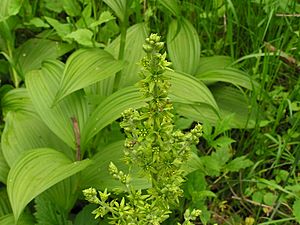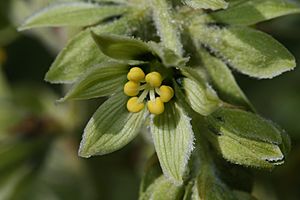Veratrum viride facts for kids
Quick facts for kids Veratrum viride |
|
|---|---|
 |
|
| Veratrum viride var. viride in flower | |
| Scientific classification | |
| Genus: |
Veratrum
|
| Species: |
viride
|
| Synonyms | |
|
Synonymy
Helonias viridis (Aiton) Ker Gawl.
Veratrum lobelianum var. eschscholtzianum Schult. & Schult.f., syn of var. eschscholzianum Veratrum eschscholtzianum (Schult. & Schult.f.) O.Loes., syn of var. eschscholzianum Veratrum eschscholtzii A.Gray, syn of var. eschscholzianum Veratrum viride var. escholtzianoides O.Loes., syn of var. eschscholzianum Veratrum eschscholtzii var. incriminatum B.Boivin, syn of var. eschscholzianum Veratrum eschscholtzii var. typicum B.Boivin, syn of var. eschscholzianum Veratrum viride subsp. eschscholtzii (A.Gray) Á.Löve & D.Löve, syn of var. eschscholzianum |
|
Veratrum viride, also known as Indian poke or corn-lily, is a plant found in North America. It grows in both the eastern and western parts of the continent. This plant is very toxic (poisonous), which means it can be harmful if touched or eaten. Farmers often consider it a problem plant because it can be dangerous to their livestock.
Contents
What is Veratrum viride?

Veratrum viride is a herbaceous (non-woody) perennial plant. This means it lives for more than two years and its stems are soft, not woody like a tree. It can grow quite tall, from about 0.7 to 2 meters (2 to 6.5 feet). The plant has a strong green stem.
Its leaves are arranged in a spiral pattern. They are large, about 10 to 35 cm (4 to 14 inches) long and 5 to 20 cm (2 to 8 inches) wide. The leaves are shaped like an ellipse or a wide spear, with heavy ribs and a hairy underside.
Flowers and Fruit
The plant produces many flowers on a large, branched stalk that can be 30 to 70 cm (1 to 2.3 feet) tall. Each flower is small, about 5 to 12 mm (0.2 to 0.5 inches) long. They have six green to yellow-green tepals (parts that look like petals).
After flowering, the plant produces a capsule (fruit) that is 1.5 to 3 cm (0.6 to 1.2 inches) long. When the fruit is ripe, it splits into three parts. This releases many flat seeds, each about 8 to 10 mm (0.3 to 0.4 inches) across.
How it Reproduces
Veratrum viride can grow new plants in two ways. It reproduces from its rhizome (underground stems) and also from its seeds.
Types of Veratrum viride
There are two main varieties (types) of Veratrum viride:
- Veratrum viride var. viride is found in eastern North America. Its flower branches stand up straight or spread out.
- Veratrum viride var. eschscholzianum grows in western North America. Its flower branches tend to droop downwards.
A similar plant, Veratrum californicum, also known as white false hellebore, grows in western North America. You can tell it apart from V. viride var. eschscholzianum because its flowers are whiter and its flower branches stand up straight.
Where Veratrum viride Grows
In eastern North America, Veratrum viride var. viride is found from southern Quebec and Labrador down to northern Georgia.
In the west, Veratrum viride var. eschscholzianum grows from Alaska and the Northwest Territory south through Yukon, British Columbia, Alberta, Washington, Idaho, Montana, and Oregon. It also reaches northwestern California.
This plant prefers wet soil. You can find it in meadows, along sunny streambanks, and in open forests. It grows from sea level in the northern parts of its range up to 1600 meters (5,250 feet) in the southeast and 2500 meters (8,200 feet) in the southwest.
Historical Uses and Dangers
Veratrum viride is a very toxic plant. If someone accidentally eats it, it can cause nausea and vomiting. If the poison stays in the body, it can lead to cold sweats and dizziness. Breathing can slow down, and heart rate and blood pressure can drop. The harmful effects come from special chemicals in the plant called alkaloids.
Native American tribes sometimes used this plant externally (on the skin) for certain purposes. In the past, it was also used in medicine to help with high blood pressure and rapid heartbeat. In the 1950s and 1960s, a special extract from V. viride called alkavervir was used to lower blood pressure. However, it is rarely used in modern medicine because of its high concentration of dangerous alkaloids. The roots of the plant contain even more of these toxic chemicals than the parts above ground.
Some tribes had a very unusual and dangerous tradition. To choose a new leader, candidates would eat a small amount of the plant's root. The last person to start vomiting would become the new leader. This shows how powerful and dangerous the plant's effects are, and it is a practice that highlights the extreme risks involved.
See also
 In Spanish: Falso eléboro verde para niños
In Spanish: Falso eléboro verde para niños

